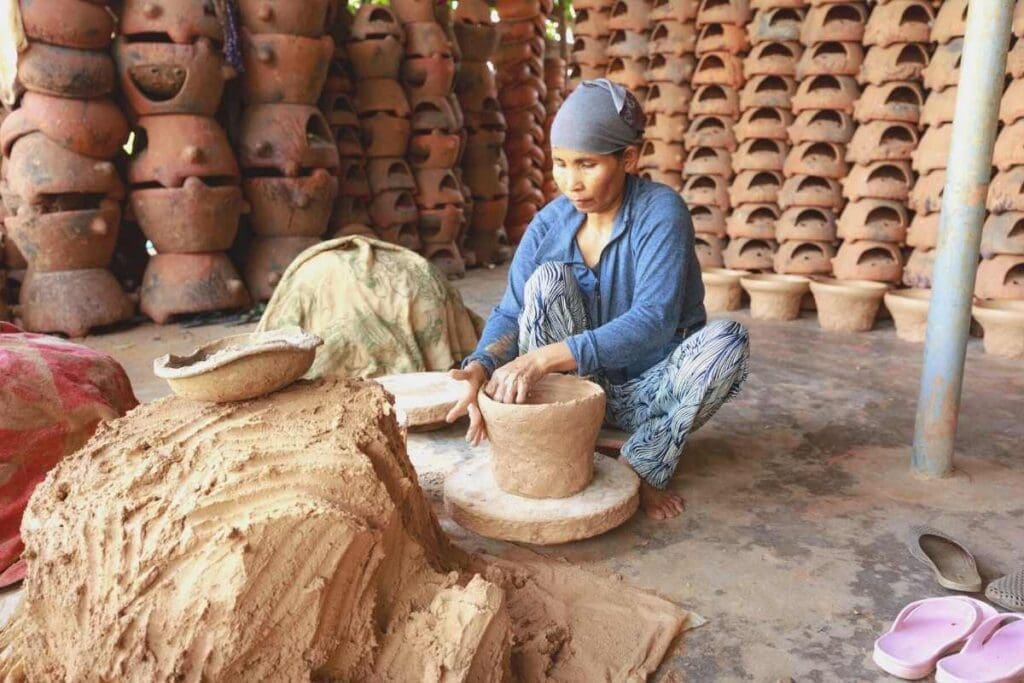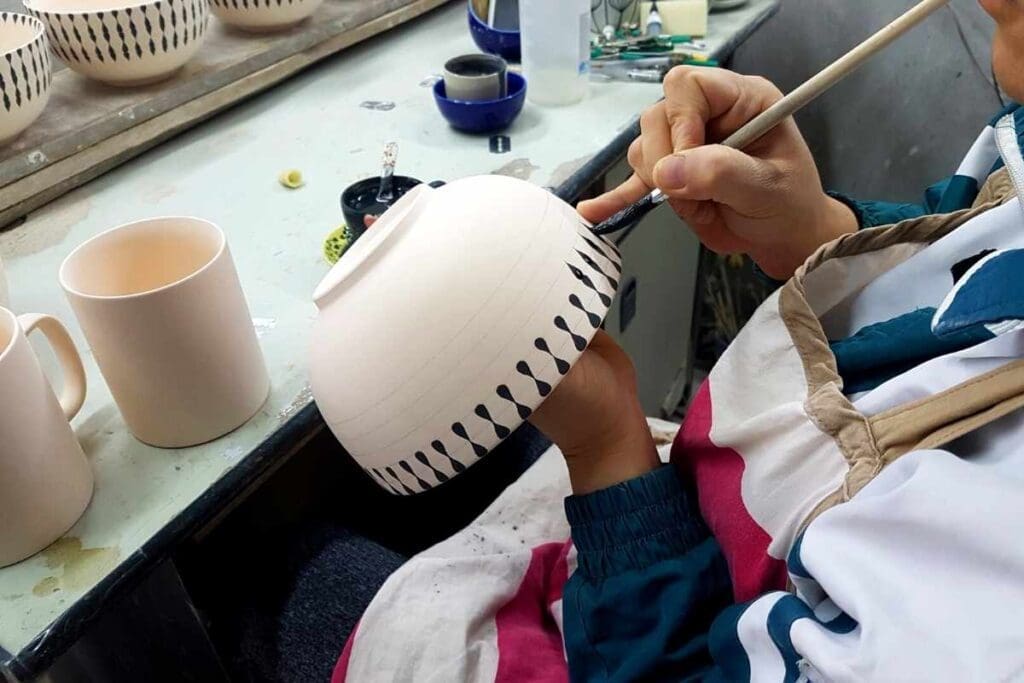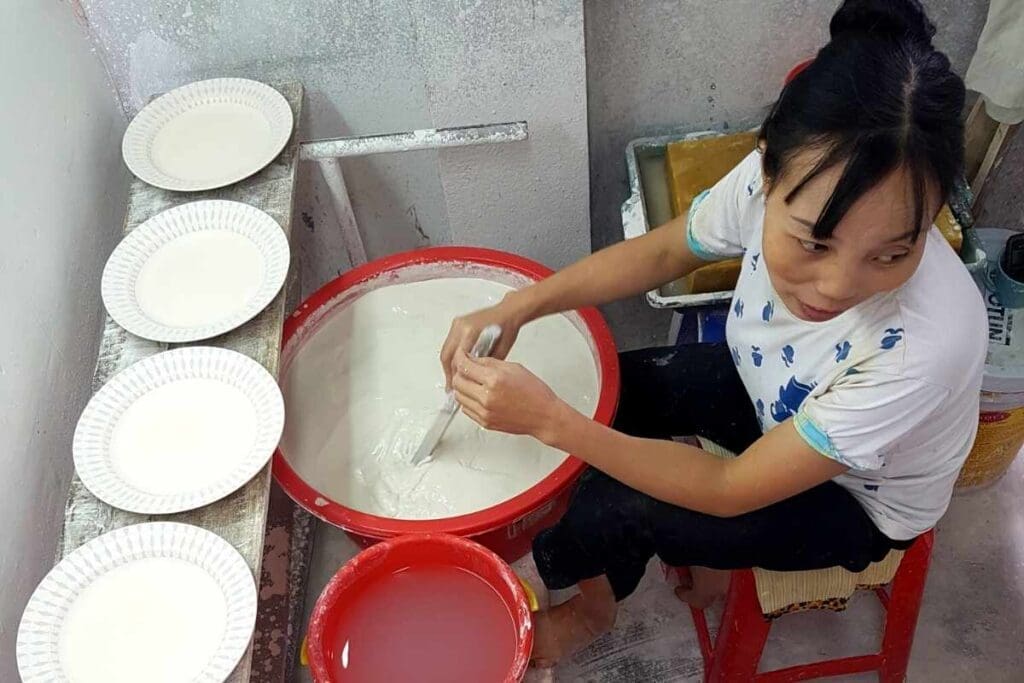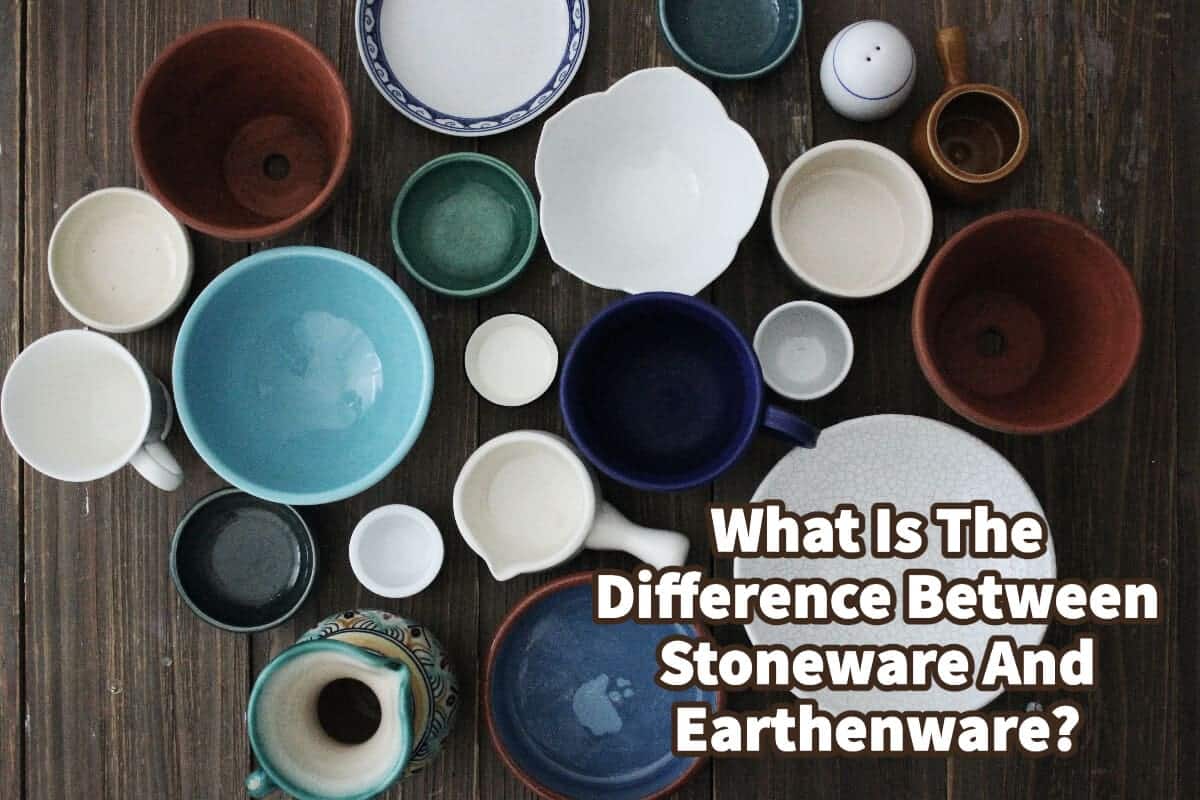The words Stoneware and Earthenware can be used interchangeably as if they are the same materials. The truth is that they are not the same material.
Earthenware is an iron-rich clay that is fired at much lower temperatures than stoneware. Due to its iron content, Earthenware will often have an orange color or cast. Stoneware is fired at a higher temperature than earthenware and is used a lot to manufacture tableware.
Table of Contents
- About Earthenware
- About Stoneware
- Differences Between Stoneware and Earthenware
- The Crucial Role of Proper Kiln Firing: 10 Reasons for Stoneware and Earthenware
- Related Content
About Earthenware
Earthenware is an iron-rich clay that can also be a bit crumbly. It is fired at a relatively low temperature of 1300 degrees F to 2120 degrees F.
As earthenware is porous, it can also break quite easily, but that can be a trade-off as earthenware has some unique and beautiful finishes that only earthenware can do.
Because earthenware is fired at a low temperature, it can create vibrant colors and can have some very vibrant-colored natural bodies.

Earthenware is one of the most popular types of clay that has been used throughout history. Archaeologists have found Earthenware that was developed 25,000 to 29,000 years ago.
Because it is a low-fire type of clay, it is one of the most popular clays but has been used throughout the history of humankind.
Earthenware’s clay can typically mold easier as it has higher plasticity. Earthenware is not a naturally watertight clay, but you can put a glaze on it to make it more watertight. This makes Earthenware a poor choice for dinnerware or items that need to hold water.
Earthenware is the preferred material for a lot of outdoor planters. This is because you can get some unique finishes with it, and the fact that it is less watertight does not matter for outdoor usage.
As Earthenware has some unique finishes, it is also a great choice to be used for Home decor objects that do not need to be watertight.
The main drawback of Earthenware is that it can break easily, so many people prefer to have ceramic or stoneware material used for decorative objects.
About Stoneware

Stoneware is the material you will see in a lot of dinnerware production. Stoneware is more complex and denser than Earthenware as it is fired at a higher temperature around 2100° to 2372° F.
Some stoneware can retain some particles and even oxidize to give a texture look or appeal. When it comes to firing temperatures, between stoneware, earthenware, and even porcelain stoneware is in the middle of these three types of materials.

Because of its unique character, stoneware can be mixed with other minerals that will be melted and added to it to give it a color or sparkle, such as dark specks throughout the clay.

Many potters prefer to use stoneware because stoneware is such a versatile clay.
Stoneware is usually the preferred material for dinnerware and indoor planters that must be watertight.
Differences Between Stoneware and Earthenware
It can be confusing is to tell the difference between whether a piece of pottery is Earthenware or Stoneware. There are some ways that you can try to identify the differences:
Clay Color
One way to tell the difference between Earthenware and Stoneware is to look at the clay color. If your clay has a reddish color or almost terra-cotta kind of clay, it should be classified as Earthenware.
Coarser Grains
You were looking at the raw clay between stoneware and earthenware, and you can find that the earthenware clay will have a coat course or more grain than the stoneware clay. Stoneware clay will have denser and more refined grains and less plasticity when compared to Earthenware.
Water Absorption Test
As we mentioned before, Earthenware does not handle water very well because it is a porous clay. If you have two pieces of pottery and you are not sure which one is Stoneware or Earthenware, you can do a simple test with water.
If you dip both in water, then calculate the water absorption rate. Any piece with a 5 to 8% absorption figure is likely Earthenware. In other words, if you see the water going into the clay, it should more than likely be an earthenware peace.
Here is how you can do a simple water absorption test:
- Record the original weight of each piece completely dry.
- Soak each of the pieces in water for at least a day.
- Bring the pieces out of the water and record the weight.
- To check the absorption rate, divide the starting weight by the new weight and multiply it by 100. This will give you the absorption percentage.
If you dip both in water, then calculate the water absorption rate. Any piece with a 5 to 8% absorption figure is likely Earthenware. In other words, if you see the water going into the clay, it is more than likely be an earthenware material.
If you see no absorption or very little, it is more than likely Stoneware or even porcelain.
As a note, some earthenware can get damaged if put in water for too long, so make sure if you are doing this test that it is a piece that either you do not mind if it is damaged or you use a piece that you know will not get damaged.
Whether you want to use Stoneware or Earthenware material for your home decor or home furnishing product will depend upon how you use it and what type of glaze you want to have as your final design and look.
The Crucial Role of Proper Kiln Firing: 10 Reasons for Stoneware and Earthenware
In the world of pottery and ceramics, the firing process is nothing short of magical. It’s the stage where raw clay transforms into sturdy, functional stoneware and earthenware that can withstand daily use. But what happens when this crucial step isn’t given the attention it deserves?
Read on as we explore ten compelling reasons why stoneware and earthenware must be adequately fired in a kiln.
1. Structural Integrity:
Proper firing ensures that the clay molecules bond together, creating a durable and structurally sound piece of pottery.
2. Hardness and Durability:
Firing at the right temperature hardens the clay, making it resistant to chipping, cracking, and breakage during everyday use.
3. Non-Porous Surface:
Effective firing seals the clay’s pores, preventing liquids from seeping through and making stoneware and earthenware ideal for holding both food and beverages.
4. Enhanced Glaze Interaction:
Correct firing temperature allows glazes to mature, resulting in vibrant, glossy finishes that enhance both aesthetics and functionality.
5. Color Development:
Proper firing brings out the full potential of color pigments in the clay and glazes, ensuring consistent and vibrant hues.
6. Reduction of Shrinkage:
Controlled firing minimizes the risk of excessive shrinkage, preserving the intended size and shape of the piece.
7. Elimination of Porosity:
Effective firing closes the tiny spaces within the clay, preventing odors and flavors from being absorbed and retained.
8. Food Safety:
Properly fired stoneware and earthenware are food-safe, with no risk of leaching harmful substances into your meals.
9. Thermal Shock Resistance:
Correct firing imparts thermal shock resistance, allowing ceramics to withstand abrupt temperature changes, such as moving from the oven to a cold countertop.
10. Artistic Potential:
Kiln firing unlocks the full artistic potential of stoneware and earthenware, enabling intricate designs, intricate patterns, and unique textures to shine through.
The firing process is the transformative moment where raw clay becomes functional and beautiful stoneware and earthenware. Neglecting this essential step can lead to structural weaknesses, compromised aesthetics, and even safety concerns.
By understanding and appreciating the significance of proper kiln firing, potters and ceramic artists can create pottery that not only delights the eye but also stands the test of time.
To find out more about how Mondoro can help you create, develop, and manufacture excellent home decor and home furniture products – including earthenware or stoneware – don’t hesitate to contact me, Anita. Check out my email by clicking here or become a part of our community and join our newsletter by clicking here.
Mondoro gives out a FREE Lookbook to anyone interested. You can receive a copy of our latest Lookbook by clicking here.
Listen to our Podcast called Global Trade Gal. You can find it on all major podcast platforms. Try out to listen to one of our podcasts by clicking here.
Subscribe to our Mondoro Company Limited YouTube Channel filled with great videos and information by clicking here.
Related Content
Earthenware, Stoneware, And Porcelain Materials
Earthenware, stoneware, and porcelain are all made by various clays and then fired. The kind of clay used and the temperature at which they are fired can make a difference in how soft or hard the end product is. Though they all seem to be similar, they are all very different materials and products.
You can discover more by reading Earthenware, Stoneware, And Porcelain Materials by clicking here.
What is the PVD Stainless Steel Coating Used On Home Decor Products?
PVD coatings are a very thin yet highly durable coating that can be placed on many different kinds of substrates, including stainless steel. A vacuum chamber with very high temperatures is used to apply the PVD coating. Though this finish is used a lot in the tech, medical, and aerospace industries, it is also used for home decor and home furniture products.
You can find out more about PVD by reading out blog What is the PVD Stainless Steel Coating Used On Home Decor Products? by clicking here.
What is the Brass and Bronze Material Used In Home Decor Products?
Brass and bronze are both copper alloys, but brass is copper and zinc, and the bronze material is copper and tin. They both look similar but have different properties and uses. When brass or bronze is made into home decor products many times they will be sand cast or use a lost wax or investment mold technique. Each of these production methods has different uses and prices that can affect the overall production.
You can find out more about brass and bronze by reading our blog What is the Brass and Bronze Material Used In Home Decor Products? by clicking here.

